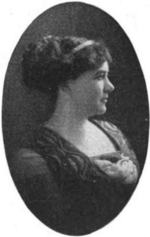Jacques Futrelle facts for kids
Quick facts for kids
Jacques Futrelle
|
|
|---|---|
 |
|
| Born | Jacques Heath Futrelle April 9, 1875 Pike County, Georgia, US |
| Died | April 15, 1912 (aged 37) North Atlantic Ocean |
| Occupation | Mystery writer, journalist |
| Period | 1905–1912 |
| Genre | Detective fiction, science fiction |
| Spouse | Lily May Peel (1895–1912) (his death) |
| Children | 2 |
Jacques Heath Futrelle (born April 9, 1875 – died April 15, 1912) was an American journalist and writer of mystery stories. He is famous for his short detective stories about Professor Augustus S. F. X. Van Dusen. This character was often called "The Thinking Machine" because he used pure logic to solve mysteries. Jacques Futrelle sadly died when the RMS Titanic sank.
Contents
Jacques Futrelle's Career
Jacques Futrelle was born in Pike County, Georgia. He started his career as a journalist. He worked for several newspapers, including the Atlanta Journal, where he helped start their sports section. He also worked for the New York Herald and the Boston Post.
In 1905, while working for the Boston American, his famous character, "The Thinking Machine," first appeared. This was in a story called "The Problem of Cell 13," which was published in parts over time.
In 1906, Futrelle decided to leave journalism to focus on writing novels. He built a house in Scituate, Massachusetts, which he called "Stepping Stones." He spent most of his time there until he passed away in 1912. His last book, My Lady's Garter, was published after his death. His wife wrote a special message in the book, dedicating it to the heroes of the Titanic.
Jacques Futrelle's Family Life
In 1895, Jacques Futrelle married another writer named Lily May Peel. They had two children together, a daughter named Virginia and a son named Jacques "John" Jr.
The Sinking of the Titanic
Jacques Futrelle was returning from Europe on the RMS Titanic. He was a first-class passenger. When the ship began to sink, he made sure his wife, Lily, got onto a lifeboat. He even had to insist she go.
Lily remembered seeing him for the last time on the deck. He was smoking a cigarette with John Jacob Astor IV, another famous passenger. Jacques Futrelle did not survive the sinking. He died in the Atlantic Ocean and his body was never found.
On July 29, 1912, just a few months after the Titanic disaster, Futrelle's mother, Linnie Futrelle, passed away in her home in Georgia. Her death was believed to be caused by the sadness of losing her son.
Jacques Futrelle's Books and Stories
Jacques Futrelle wrote several novels and collections of short stories, mostly mysteries.
Novels
- The Chase of the Golden Plate (1906)
- The Simple Case of Susan (1908)
- The Diamond Master (1909) – This book was later made into silent films.
- Elusive Isabel (1909)
- The High Hand (1911)
- My Lady's Garter (1912)
- Blind Man's Buff (1914)
Short Story Collections
- The Thinking Machine (1907)
- "The Flaming Phantom"
- "The Great Auto Mystery"
- "The Man Who Was Lost"
- "The Mystery of a Studio"
- "The Problem of Cell 13" (1905) – This is one of his most famous stories.
- "The Ralston Bank Burglary"
- "The Scarlet Thread"
- The Thinking Machine on the Case (1908), also known as The Professor on the Case in the UK.
- "The Stolen Rubens"
Other Short Stories
- "The Problem of Cell 13" (1905)
- The Gray Ghost (1905)
- The Man Who Found Kansas (1906)
- "The Phantom Motor"
- "The Grinning God" – This story was a special experiment. Jacques Futrelle's wife, May Futrelle, wrote the first part, which was a ghost story. Then, "The Thinking Machine" provided a logical explanation for the spooky events.
See also
 In Spanish: Jacques Heath Futrelle para niños
In Spanish: Jacques Heath Futrelle para niños


